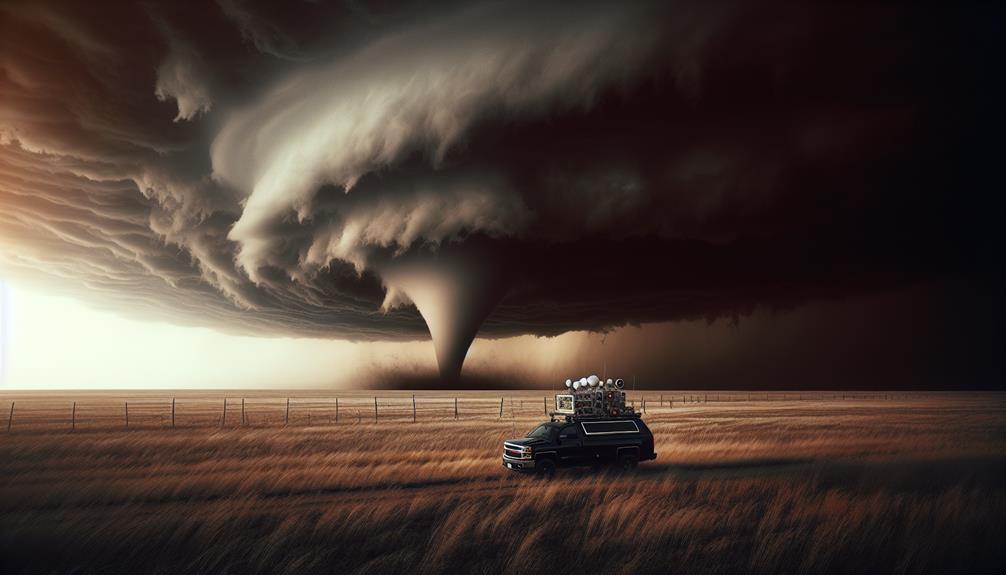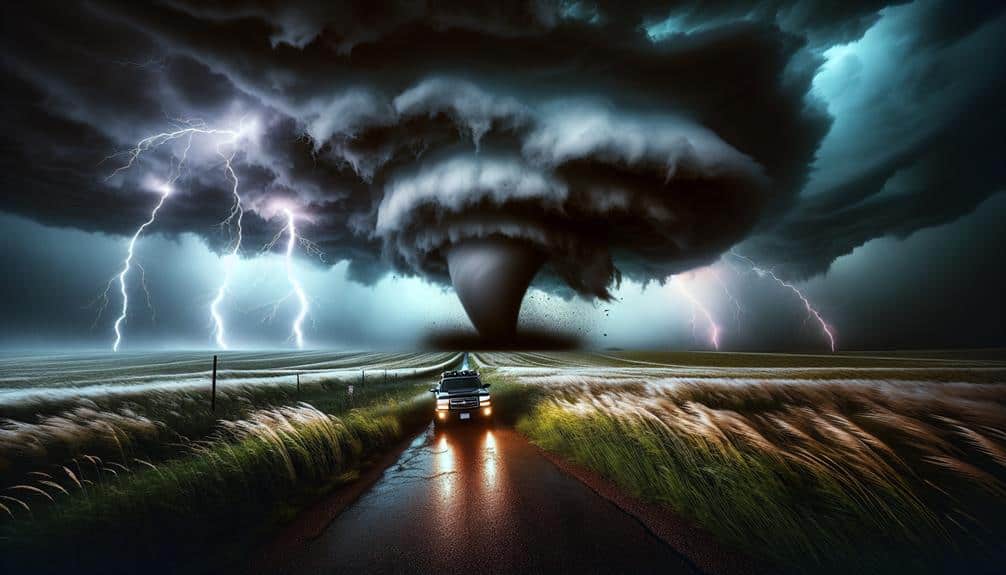To pursue a career in storm chasing, we start with a degree in meteorology or atmospheric science, focusing on weather prediction and data interpretation. It's essential to gain hands-on field experience to link theory with real-world storm dynamics. Equipment like high-resolution cameras, drones, and reinforced vehicles are essential for safety and capturing storm footage. Networking with the storm chasing community provides valuable insights and shared safety protocols. Job opportunities range from research roles to media coverage and freelance chasing. Let's continue to uncover the specific steps and tools vital for succeeding in this exhilarating field.
Key Points
- Obtain a degree in meteorology or atmospheric science to understand weather patterns and prediction.
- Gain hands-on field experience to bridge theoretical knowledge with real-world storm chasing.
- Equip your vehicle with essential technology and safety gear for effective and safe storm chasing.
- Develop strong observational and decision-making skills for assessing risks and predicting storm movements.
Understanding Storm Chasing
In storm chasing, we meticulously track and analyze severe weather patterns to anticipate and document powerful storms. By understanding storm patterns, we position ourselves to capture nature's most extreme moments without compromising our safety. It's not just about the thrill; it's about the science and the stories that these storms tell.
Safety precautions are paramount. We can't stress enough the importance of having a well-defined safety plan. Each storm is unique, demanding a keen awareness of changing conditions. We analyze radar data and atmospheric readings to predict a storm's path and potential hazards. This helps us determine our approach and exit points, ensuring we don't get trapped in dangerous situations.
Our vehicles are equipped with advanced technology: GPS systems, Doppler radar, and communication tools. These aren't just gadgets; they're our lifelines. We stay connected with meteorological services and fellow chasers to share real-time information, enhancing our understanding of storm patterns and improving our safety measures.
As storm chasers, we embrace the freedom to explore and document the raw power of nature, but we do so with a disciplined respect for the forces we pursue. Safety and preparation are our guiding principles.
Educational Requirements
Let's start by examining the educational paths that best prepare us for storm chasing.
We'll look at relevant degree programs, necessary meteorology certifications, and the pivotal role of field experience.
Understanding these elements will give us a clear roadmap to succeed in this dynamic and challenging career.
Relevant Degree Programs
When considering a career in storm chasing, obtaining a degree in meteorology or atmospheric science provides the essential knowledge and skills needed to understand and predict severe weather patterns. With these degrees, we gain a deep understanding of atmospheric processes and the ability to interpret complex data, which is essential for making accurate weather forecasts.
Courses often cover remote sensing technologies and geographic information systems (GIS), both of which are indispensable tools for storm chasers. Remote sensing helps us monitor atmospheric conditions in real-time, using satellites and radar to track storm development and movement. This technology allows us to gather critical data about wind speeds, precipitation, and temperature changes, enabling us to make informed decisions in the field.
Meanwhile, GIS helps us analyze spatial data and create detailed maps that illustrate weather patterns and potential storm paths. This spatial awareness is vital when maneuvering the unpredictable terrains where storms frequently occur.
Meteorology Certifications Needed
While a solid educational background in meteorology or atmospheric science forms the foundation, obtaining specific meteorology certifications further validates our expertise and readiness for a career in storm chasing. Certifications such as the Certified Broadcast Meteorologist (CBM) or the American Meteorological Society's (AMS) Certified Consulting Meteorologist (CCM) not only elevate our professional standing but also greatly enhance our job prospects. These credentials demonstrate our commitment to professional development and advanced training, essential for staying ahead in this competitive field.
To earn these certifications, we typically need to pass rigorous exams that test our theoretical knowledge and practical skills. This ensures we're well-equipped to interpret weather data accurately and make real-time decisions during severe weather events. Such qualifications also open doors to career advancement, positioning us as experts capable of taking on leadership roles or specialized tasks within the storm-chasing community.
Moreover, these certifications often require continuing education, keeping us updated with the latest advancements in meteorology. Staying informed about cutting-edge research and technologies ensures we remain at the forefront of our field, enhancing not only our safety but also the quality of our work. This continuous learning aligns perfectly with our desire for freedom and expertise in storm chasing.
Field Experience Importance
Gaining hands-on field experience is essential for storm chasers, as it allows us to apply theoretical knowledge in real-world scenarios and develop essential skills for safely maneuvering severe weather conditions. Real-world exposure is critical; it bridges the gap between classroom learning and the unpredictable nature of storms. We need that hands-on training to understand the nuances of storm patterns, gauge distances, and read atmospheric signs that can't be replicated in a textbook.
Field research provides us with practical knowledge, making us adept at using meteorological instruments, navigating challenging terrains, and making split-second decisions. This experience sharpens our observational skills and hones our ability to predict storm movements accurately. Being in the field teaches us teamwork and communication, both vital when coordinating with fellow chasers and emergency services.
Moreover, real-world exposure prepares us mentally and physically for the demands of storm chasing. We learn to manage the adrenaline and maintain composure under pressure. It also cultivates a respect for nature's power, reinforcing the importance of safety protocols.
Ultimately, hands-on training and field research are indispensable in transforming theoretical meteorology into practical, life-saving storm chasing expertise.
Essential Skills
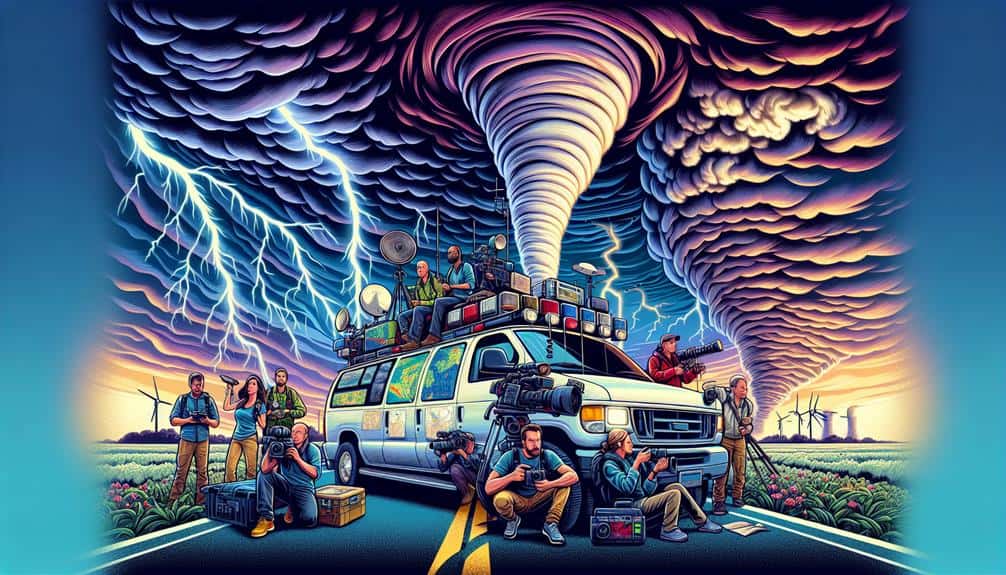
To excel in storm chasing, we need a strong foundation in meteorology, sharp observational skills, and the ability to make quick, informed decisions under pressure.
Understanding weather patterns isn't just an academic exercise; it's crucial for our safety and effectiveness in the field. We must be skilled at risk assessment, evaluating potential threats not only from the storm itself but also from rapidly changing conditions around us.
Effective communication skills are paramount. Whether we're coordinating with fellow chasers, relaying critical updates to meteorological services, or sharing real-time data with the public, clear and concise communication can make the difference between a successful chase and a dangerous situation.
Analyzing satellite imagery, interpreting Doppler radar data, and recognizing weather fronts require sharp analytical abilities. We've to trust our instincts while relying on our training to read the skies accurately.
In the field, adaptability is key. Conditions can shift in an instant, so we must be prepared to modify our plans on the fly. Mental agility and physical stamina go hand in hand, ensuring that we stay sharp and responsive under stress.
Necessary Equipment
Our success and safety in storm chasing hinge on having the right equipment at our disposal. First and foremost, our camera gear must be excellent. High-resolution cameras, lenses with various focal lengths, and sturdy tripods are essential for capturing those breathtaking storm images.
We also rely on drones to get aerial views, adding an extra dimension to our footage.
Communication devices are another critical component. Reliable two-way radios and smartphones with strong signal boosters guarantee we can stay in touch with our team and receive real-time weather updates. These devices can be lifesavers when maneuvering through treacherous conditions.
Vehicle modifications are indispensable for storm chasers. Our vehicles should be equipped with reinforced windows to withstand hail, skid plates to protect the undercarriage, and all-terrain tires for navigating through rough landscapes. Additionally, a roof-mounted weather station can give us instant readings on temperature, wind speed, and atmospheric pressure.
Don't forget the protective gear. Helmets, fire-resistant clothing, and sturdy boots are non-negotiable when we're in the thick of a chase. This gear not only protects us from flying debris but also guarantees we're ready for any unexpected hurdles nature throws our way.
Job Opportunities
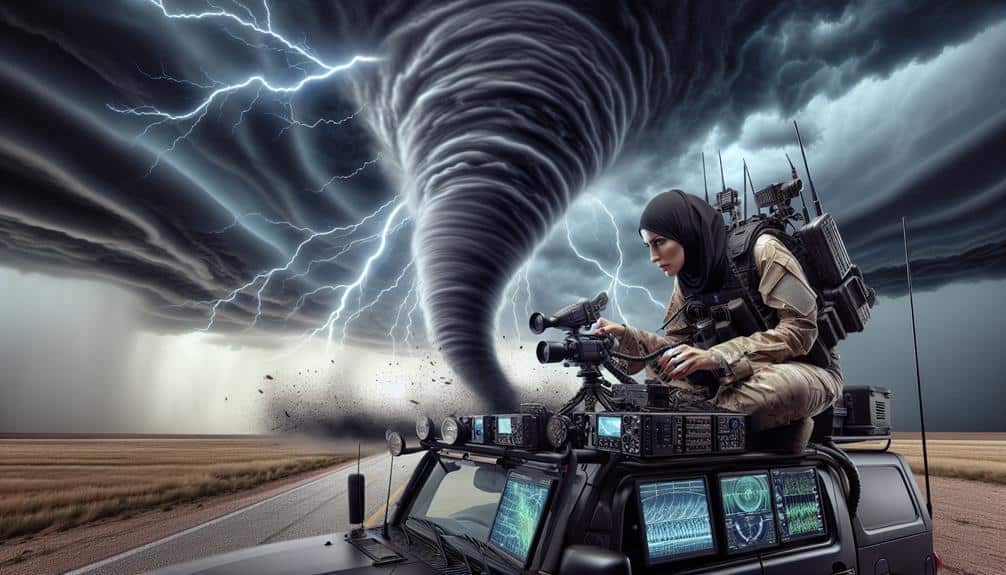
While having the right equipment is essential for our safety and success, understanding the job opportunities available in storm chasing can help us turn our passion into a sustainable career.
There are several paths we can take, each offering unique challenges and rewards. Some of us may find job placement with research institutions, where our data collection and analysis skills contribute to advancing meteorological science. Others might work with media outlets, providing real-time storm coverage that thrills audiences and raises public awareness.
For those of us seeking adrenaline and independence, freelance storm chasing could be the ideal route. We can sell our footage and reports to news organizations, weather channels, and educational platforms. Social media also offers opportunities for building a personal brand, attracting sponsors, and creating a steady revenue stream.
Salary potential in storm chasing varies widely based on experience, specialization, and employer. Those working in research or for established media companies often enjoy more stable incomes, whereas freelancers might experience fluctuating earnings. However, the freedom and excitement of the chase can more than compensate for financial uncertainties.
Ultimately, aligning our career paths with our individual passions and strengths ensures not just job placement, but a fulfilling professional life.
Safety Precautions
Prioritizing safety in storm chasing means we must thoroughly prepare and equip ourselves with the knowledge and tools to handle volatile weather conditions. Our first step is understanding the basics of risk management. We need to evaluate potential hazards, such as high winds, lightning, and flash floods, and develop strategies to reduce these risks.
This includes consistently monitoring weather updates and having backup plans for sudden changes in storm behavior.
Emergency response is another crucial aspect. We should always carry a well-supplied emergency kit, including first aid supplies, water, non-perishable food, and communication devices. Ensuring our vehicle is in top condition, with a full tank of fuel and emergency repair tools, is also essential.
GPS systems and reliable maps are essential for navigating unfamiliar terrains efficiently.
Furthermore, training in meteorology and first aid can greatly enhance our preparedness. Participating in storm-chasing workshops and simulations can provide hands-on experience and improve our decision-making skills under pressure.
Maintaining constant communication with local authorities and fellow storm chasers ensures we're never isolated during critical moments.
Ultimately, by combining thorough preparation, effective risk management, and a strong emergency response plan, we can chase storms with confidence and safety, embracing the thrill while respecting the power of nature.
Networking and Community
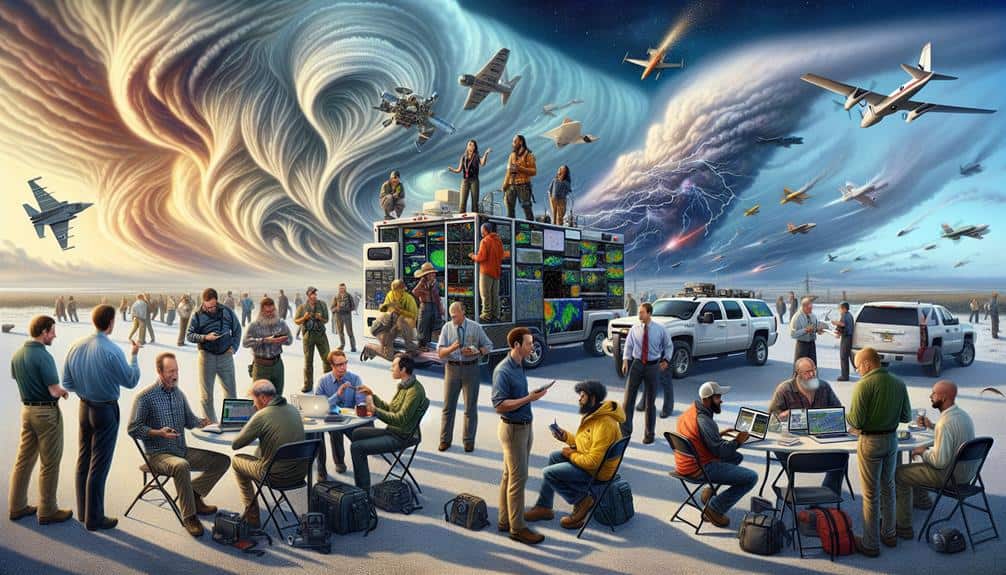
Building strong connections within the storm chasing community is essential for sharing insights, improving safety, and enhancing our overall experience. By networking effectively, we position ourselves to learn from seasoned chasers and contribute to a collective pool of knowledge that benefits all of us.
Online resources are an invaluable asset. Platforms like Stormtrack and various Facebook groups offer forums for discussing weather patterns, sharing storm simulation tools, and planning chase strategies. These virtual spaces allow us to stay updated on the latest meteorological advancements and technological innovations.
Local groups are equally important. Joining a regional storm spotting team not only helps us build local expertise but also fosters a sense of camaraderie. These groups often conduct training sessions, where experienced chasers share essential safety protocols and real-time storm spotting techniques. The hands-on experience we gain here is irreplaceable.
Attending storm chasing conventions and workshops can further fortify our network. Events like ChaserCon provide opportunities to meet industry experts, participate in panel discussions, and engage in advanced storm simulation exercises.
Frequently Asked Questions
How Do Storm Chasers Balance Their Work and Family Life?
Balancing work and family life is like walking a tightrope; the challenges are real. We rely on family support and prioritize time together, ensuring work doesn't overshadow our personal lives. It's a constant, rewarding effort.
What Are the Common Misconceptions About Storm Chasing as a Career?
People often think storm chasing is all thrills and excitement because of media portrayal, but in reality, we follow strict safety precautions. The risks are real, and it's not as glamorous as it's shown.
Are There Any Legal Issues or Permits Required for Storm Chasing?
While the thrill of storm chasing beckons, we must balance it with responsibility. Permits and regulations vary by location, but adhering to safety precautions, ethical considerations, and mitigating environmental impact guarantees we chase storms without compromising our freedom.
We navigate through different weather conditions by prioritizing equipment preparation and safety measures. Effective communication and strong teamwork dynamics are essential. We constantly share real-time data to guarantee everyone's safety while chasing the thrill of the storm.
What Are the Mental Health Challenges Faced by Storm Chasers?
Sailing through the stormy seas of our minds, we face intense stress and anxiety. We rely on coping strategies and self-care, while stress management and resilience-building become our lifeboats, ensuring our mental health stays afloat.

